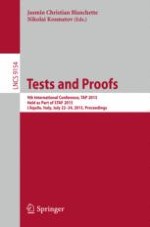This book constitutes the refereed proceedings of the 9th International Conference on Tests and Proofs, TAP 2015, held in L` Aquila, Italy, in July 2015, as part of the STAF 2015 Federated Conferences. The 11 revised full papers and 1 short papers presented together with 3 invited talks were carefully reviewed and selected from 21 submissions. The accepted papers contribute to various testing techniques (model-based, property-based, grammar-based, bounded-exhaustive), fault localization, model-driven engineering, as well as model coverage, consistency and validation, among others. Many papers rely on interactive and automatic theorem provers, including SMT solvers and model checkers.
